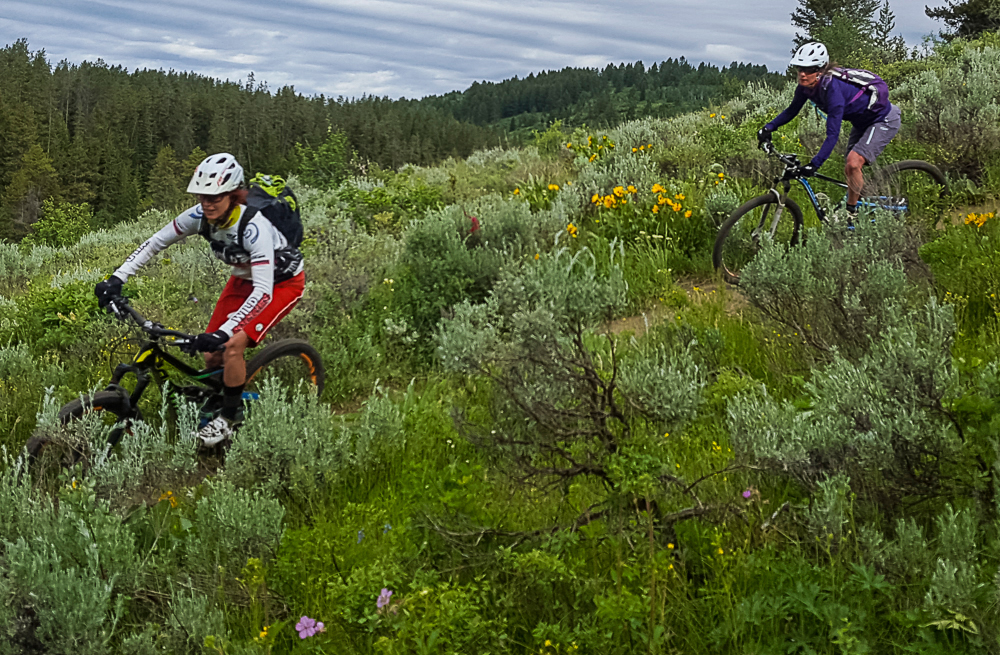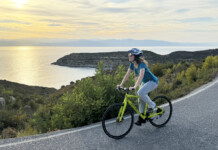By John Shafer — Every year my wife and I try to make a road trip to a new place. Since I’m primarily a mountain bike and adventure photographer, I look for destinations with great landscapes and trail systems. My wife Jenni writes about beer at Craftybeergirls.com so we also look for breweries to visit. This year, we decided on the Santa Fe Mountain Fest. It checked a lot of our travel boxes: we’d never been to New Mexico and the festival combines bikes, beer, food and music. Bonus: it’s in September – the best time to visit New Mexico because it’s chile season!
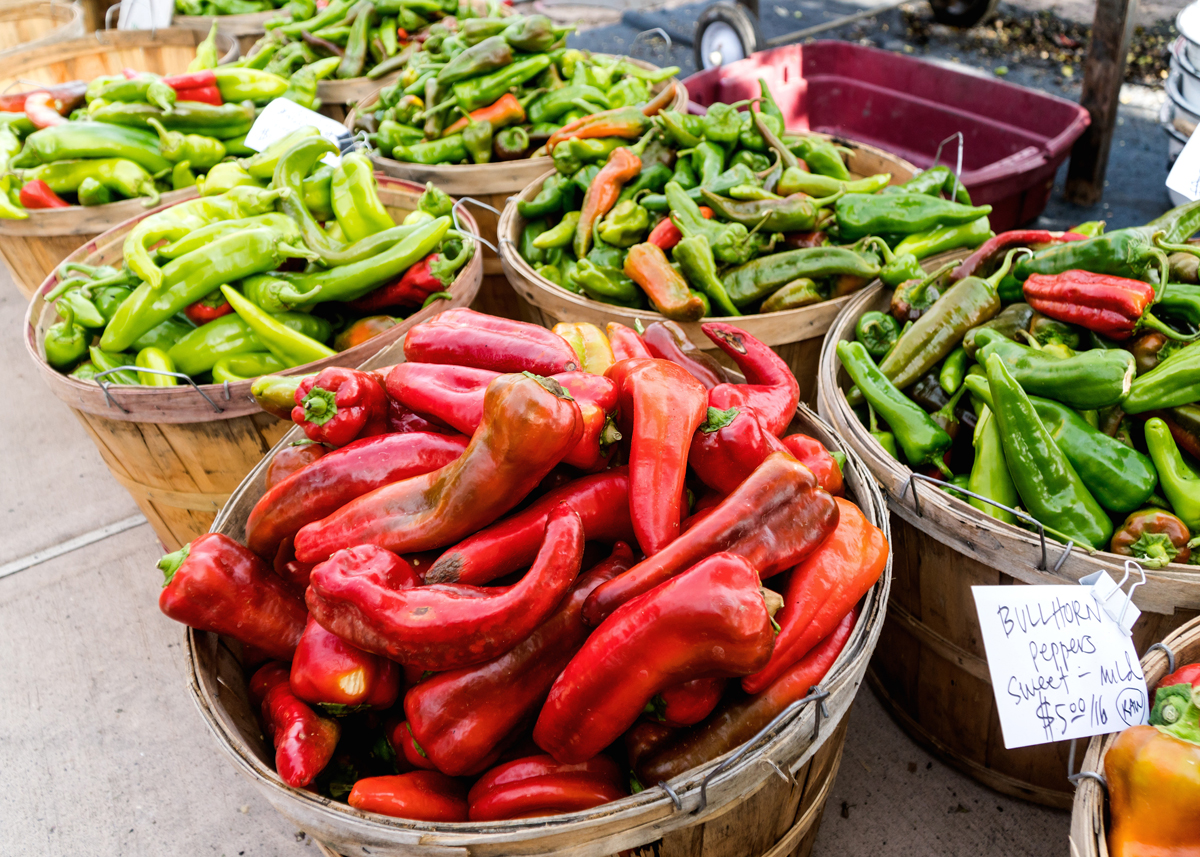
As cool as the Santa Fe Mountain Fest looked on paper, it was really just an excuse for a New Mexico road trip. We had a week to explore on our way to the festival so we took our time getting to Santa Fe. We spent a couple of days in Durango, Colorado then headed into New Mexico with stops in Farmington, Chaco Canyon and Truchas, where we spent a couple days visiting my aunt and uncle before driving to Santa Fe for the festival.
We found New Mexico to be a strange juxtaposition of familiar Southwestern landscapes in what felt like a different, much older country. In fact, New Mexico is a different, older country. Although it was “discovered” by the Spanish, the culture is separate and unique from Mexico with deep native roots and influence. The city of Santa Fe was founded in 1610 and New Mexican culture is ancient compared to most of the US. Coming from Salt Lake City, it feels mystical and old European-Catholic, with crumbling, abandoned adobes, centuries-old churches and roadside memorials called, “descansos,” around every bend. There’s also New Mexican cuisine, which is similar to Mexican food but with its own smoky, chile-based flavors.
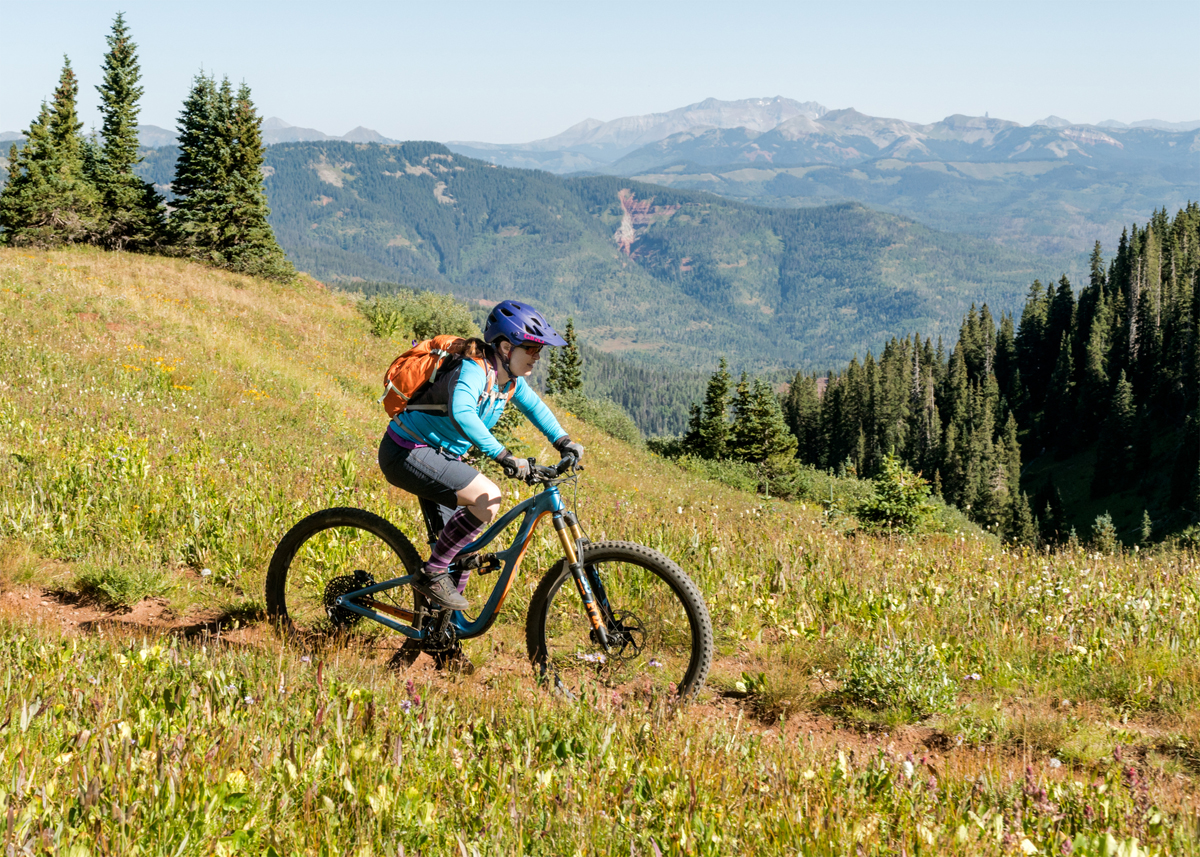
We started our trip by driving to Durango where we spent a couple of days at a friend’s house, visited some breweries and rode the southernmost section of the Colorado Trail. Our Durango ride was actually one of the highlights of the trip. It started with a shuttle to Kennebec Pass (11,600 ft. /3600 m) courtesy of Hermosa Tours. It’s a 20+ mile ride down into Durango with 6000 feet of descending and a 1000 foot climb in the middle. It’s a rowdy ride with a lot of rocks and exposure and not recommend for inexperienced riders. However, if you like big, rowdy backcountry rides, it’s not to be missed. Don’t underestimate that climb in the middle, though – it’s a bitch.
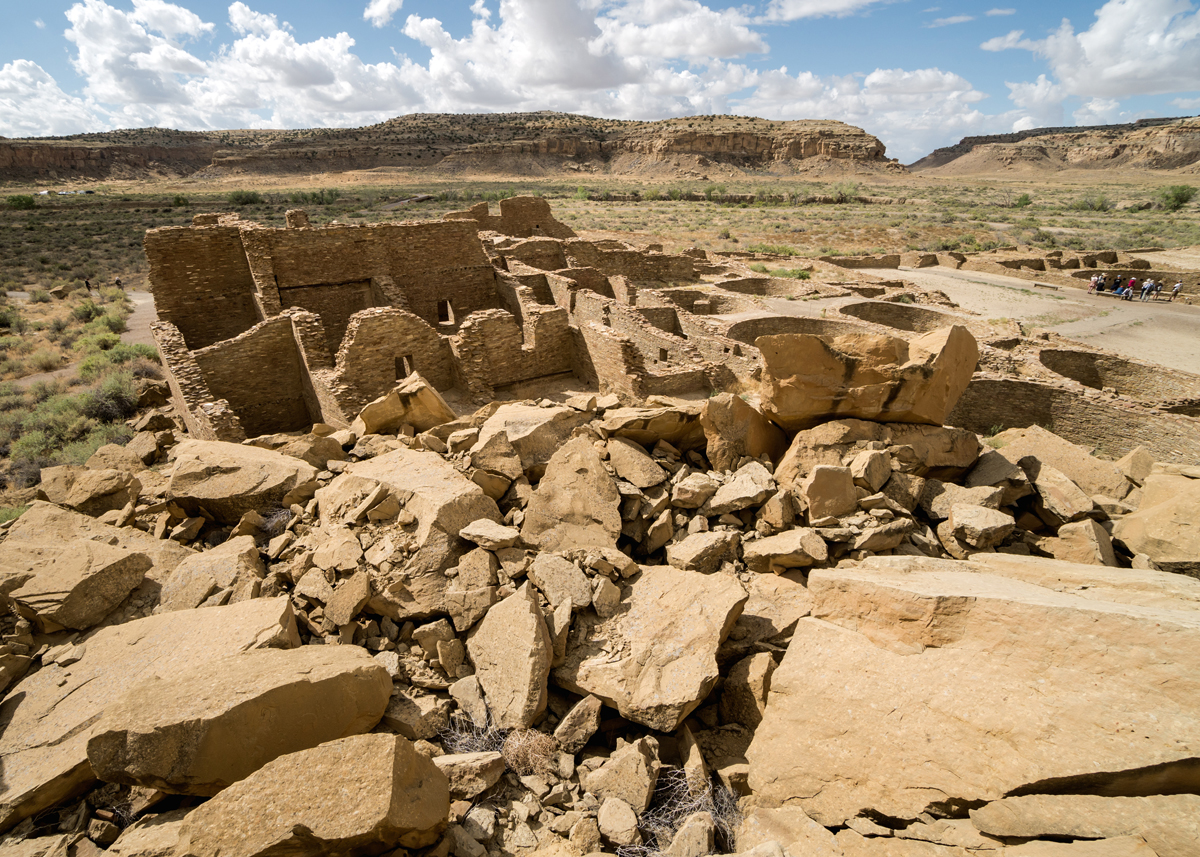
We spent our first night in New Mexico camped at Angel Peak, a badlands basin a bit south of Farmington. The next day left the main highway to see the ruins at Chaco Canyon, a place I’ve wanted to visit for decades. It’s a long drive on a washboard dirt road to get to Chaco Culture National Historical Park, but it’s worth it. Between 800 and 1300 AD, Chaco Canyon was the center of a huge native community that stretched for hundreds in every direction. It has some of the best-preserved Great Houses in the Southwest. Besides being of historical significance, it’s a beautiful location and well worth the long, rough drive. We didn’t have a lot of time so we only toured one of the pueblos but it was still worth the trip. Next time we’ll see about staying in the campground and spending more time exploring the canyon and ruins.
From Chaco Canyon, we continued southeast on US 550 through a classic Southwestern landscape of small mesas, sage, and scrubby pinyon pines. Just north of Cuba, New Mexico we turned off the main highway and headed east into the mountains. We drove through tiny, seemingly-abandoned mountain villages with crumbling adobes and ancient-looking cemeteries. After a couple of hours of 45 mile-per-hour roads, we descended into a high-desert valley, passed the road for Georgia O’Keeffe’s Ghost Ranch and followed the Rio Chama until it merged with the Rio Grande. After over 24 hours of seeing not much but high desert and a few native villages, we were back in the world of strip malls, Walmart and traffic. In Española, we made a left and wove our way east through the old New Mexico communities of Santa Cruz and Chimayo, then up a long grade into Truchas.
Truchas is about forty miles north of Santa Fe on the “High Route” to Taos. It’s in the foothills of the Sangre de Christo Mountains at an altitude of 8000 feet, in the shadow of 13,000-foot Truchas Peak. There’s not much to Truchas. The local gas station, bar & grill and convenience store are all closed. Aside from a few artist’s studios and beautiful views of the mountains above and valley below, there’s no reason to stop. However, it does have some fame as the location for Robert Redford’s 1988 movie, “The Milagro Beanfield War.” It’s a great movie and Truchas hasn’t changed much, except you see far fewer people there in real life.
We spent a day exploring Truchas, Chimayo and the surrounding area. Highlights of our time in Truchas were the Santuario de Chimayo, visiting local artist studios and eating at a couple of the outstanding local restaurants. El Santuario de Chimayo is an adobe chapel that dates to the early 1800s. It’s famous for its healing dirt and is sometimes called the “Lourdes of America.” There’s a small pit in a room at rear of the chapel where believers can take some dirt to heal their ills. It’s a registered National Historic Landmark and according to Wikipedia it gets nearly 300,000 visitors a year.
Chimayo is also famous for their local chiles. The Chimayo pepper is an heirloom chile with its own US Patent and Trademark Office certification mark. Adjacent to the Santuario are a few small shops that sell religious souvenirs, local art and all kinds of Chimayo chile products. Just up the street is Rancho De Chimayo, a popular restaurant that specializes in New Mexican cuisine. We ate there our first night in Truchas. A typical meal includes New Mexican specialties like sopapillas, posole, handmade tortillas and Chimayo red and green chile. My favorite is carne adovada, pork in Chimayo red chile sauce. Just thinking about it makes my mouth water.
On Friday morning, we finally headed down to Santa Fe for the festival. Our plan was to visit a bike shop, explore the city a bit and then head over to the festival venue for the opening evening’s festivities. Unfortunately, we found the city tough to navigate in our big, four-door F150 – especially with bikes on a hitch rack and a cab full of camera gear. If we’d known, we might have reserved a motel for the night instead of camping. We’ll just have to save playing tourist for our next visit.
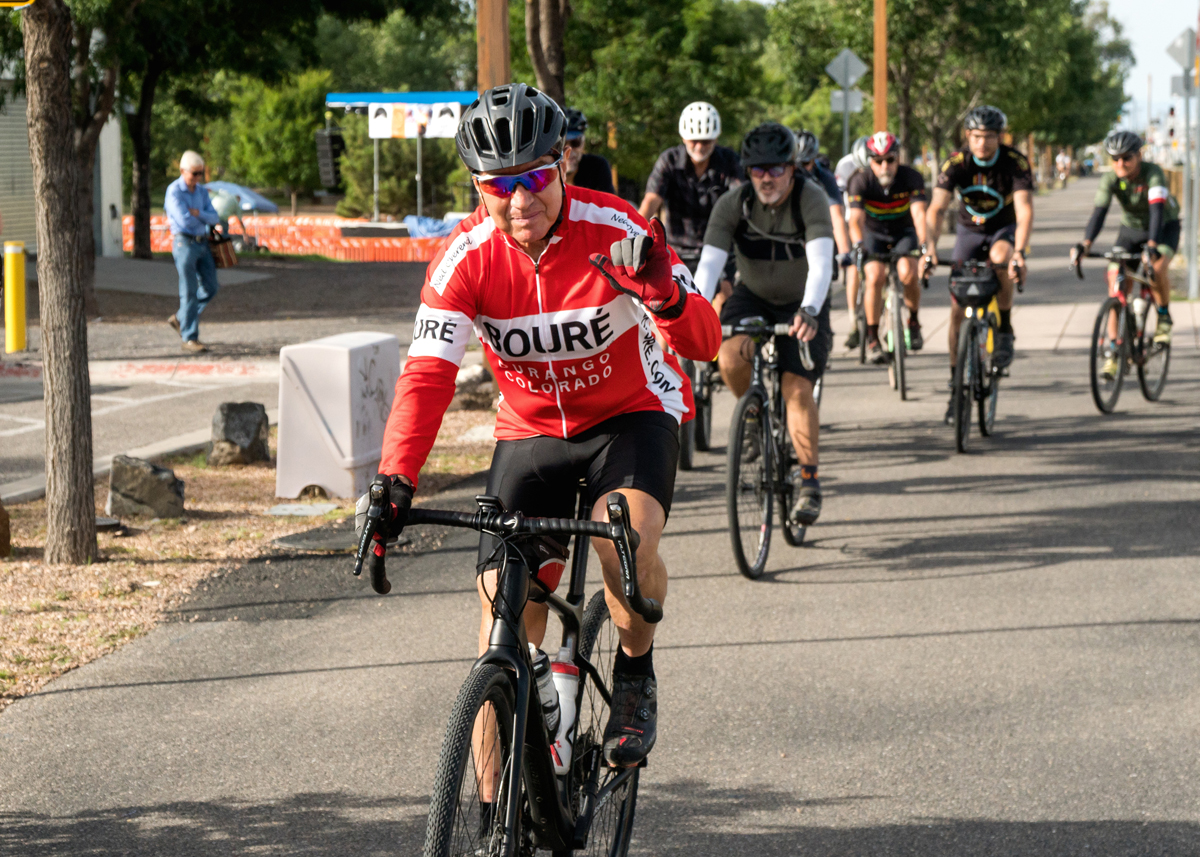
The Santa Fe Mountain Fest was held at the Santa Fe Railyard Park in the middle of the city – not the kind of location we’re used to for a bike festival. The opening night had food trucks, beer vendors and an outdoor concert with Black Joe Lewis & the Honeybears, a fantastic, guttural blues/funk act from Austin, Texas. The concert was free to the public and thanks to Santa Fe’s great network of bike paths, a lot of people left their cars home and pedaled to the event.
Saturday was the busiest day of the festival, with all kinds of activities, including a trail run, guided bike rides, a climbing wall, gear expo and food trucks. There also happens to be an excellent farmer’s market just a block away with all kinds of food, chile roasting, coffee, art, jewelry and more. I enjoyed the scent of roasting chiles and had a tasty lunch of green chile papusas and green chile focaccia.
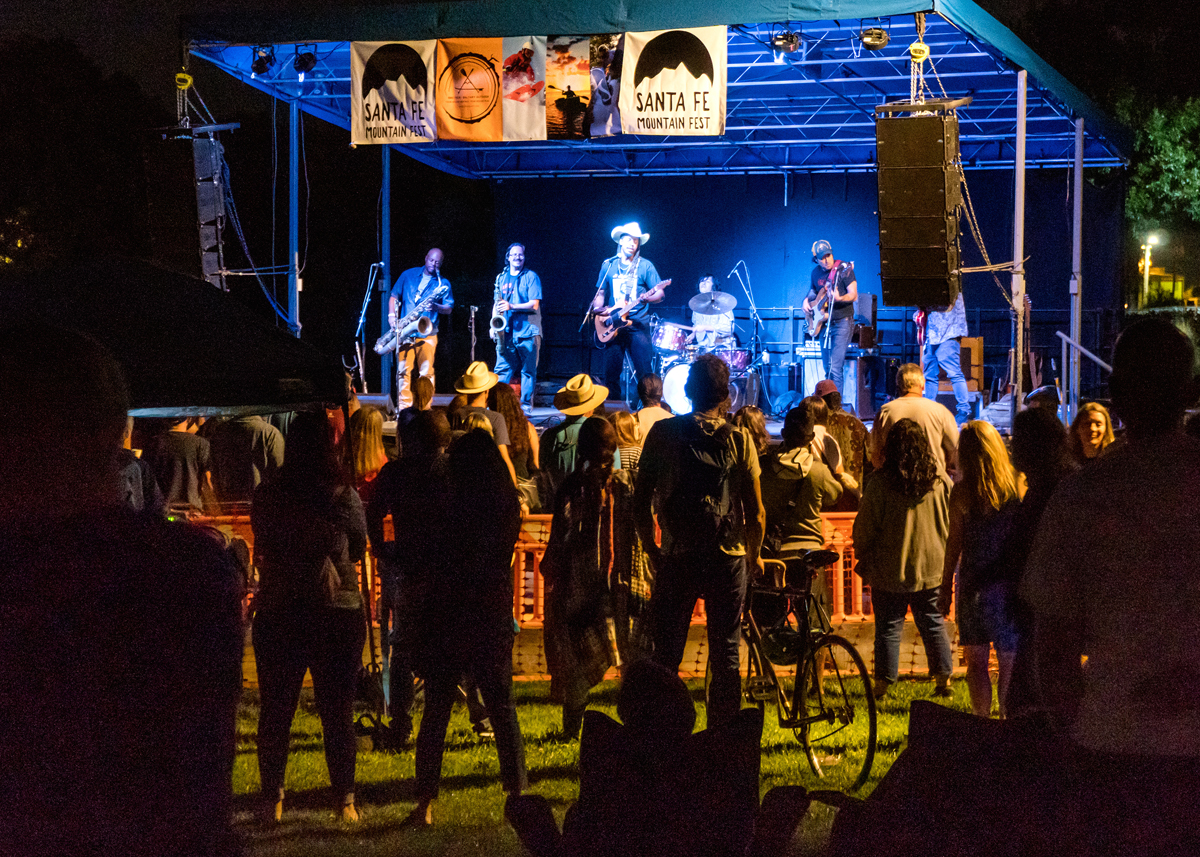
A bunch of bike rides were scheduled on Saturday, most of which started and finished at the Railyard Park. The Santa Fe Mountain Fest has a refreshing diversity of bike activities – from guided mountain bike rides to an urban ride called, “Funky Trails & Short-cuts.” One thing they don’t have is racing. All the rides are designed for fun and inclusion.
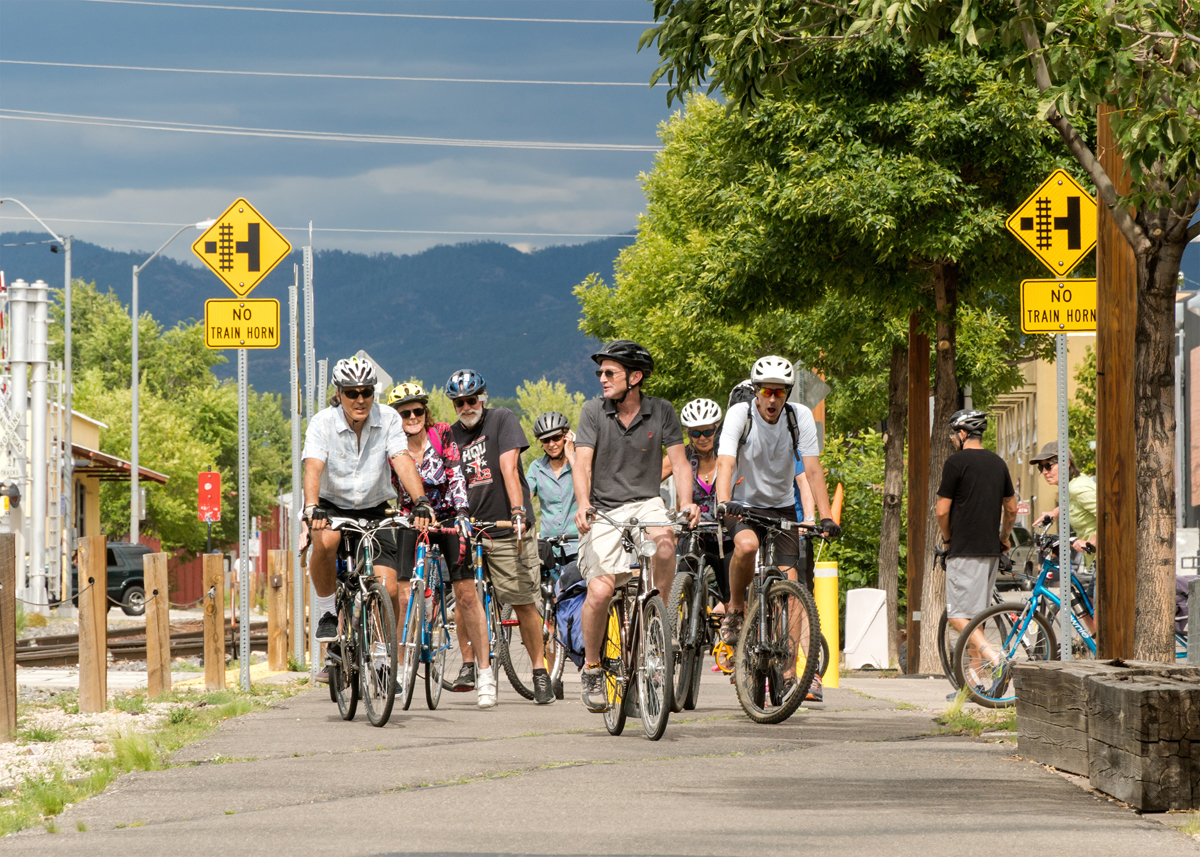
The most ambitious events were the Santa Fe Haka and the Caja del Rio Gravel Grinder. The Haka was a, “mountain bike marathon,” in the mountains above Santa Fe. It offered two options, a short 17 mile course and, “a serious undertaking,” a 31-mile course with over 8000 feet of climbing. The Caja del Rio Gravel Grinder took drop bar riders on a dirt tour of the desert outside Santa Fe. My wife Jenni joined a group doing a pedal-powered brewery tour. They rode bike paths to three local brewers, Second Street Brewery, Blue Corn and Santa Fe Brewery, for guided tours, beers and food. She had a great time. You can read her story about this trip on her web site, craftybeergirls.com.
Saturday evening was to be a repeat of Friday’s concert, beer and food trucks program. Unfortunately, it started raining that afternoon and the evening’s festivities were canceled due to thunderstorms. We were disappointed but took advantage of the free time to eat at nearby Cowgirl Café. It’s a fun, Southwestern BBQ-focused restaurant and we enjoyed the best green chile burgers we’ve ever had.
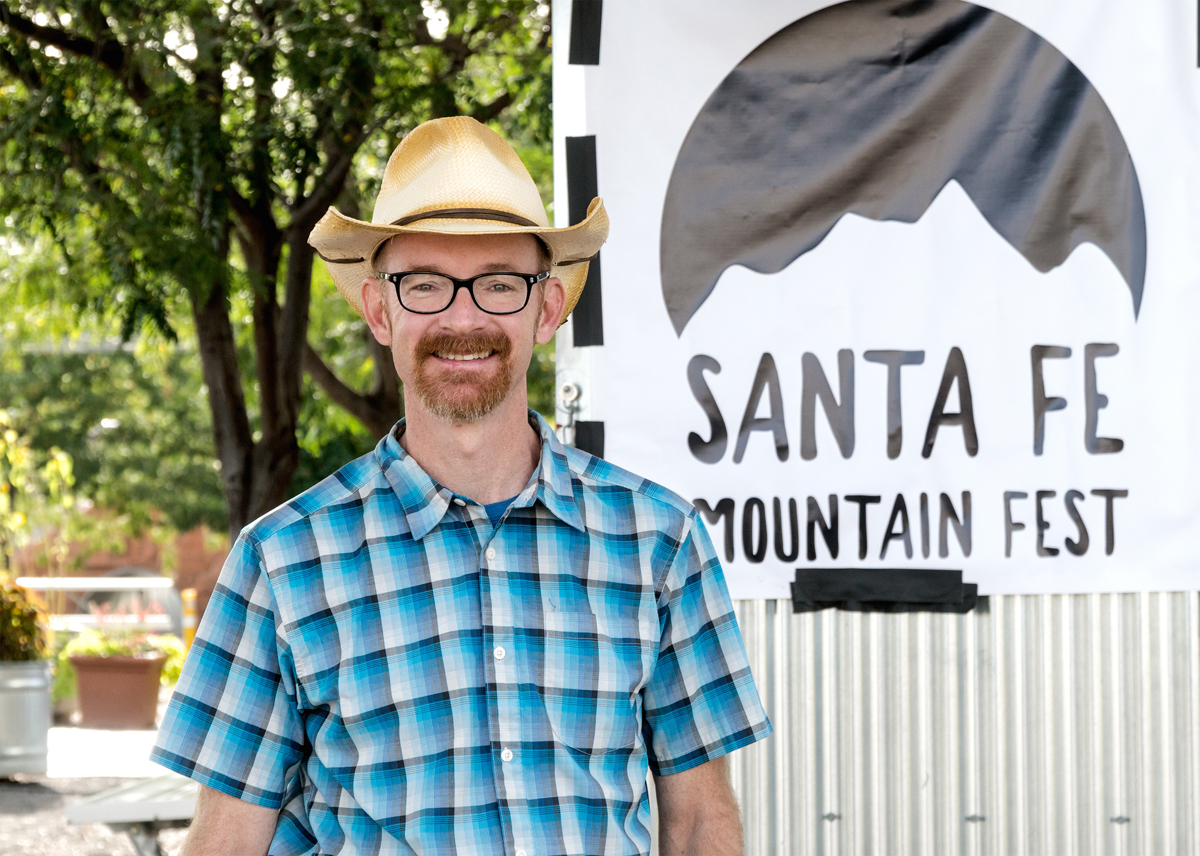
Sunday, the final day of the festival, was what I’d been waiting for. The event moved to Galisteo Basin Preserve, about 20 miles away in the desert south of Santa Fe. Festival promoter, Tim Fowler, was kind enough to show us around and we had a good time exploring the Preserve trail system. The landscape, dirt and trail quality reminded us a lot of blue trails at Fruita’s Eighteen Road trail system and the green and blue stuff at Moab’s Brand Trails (a.k.a. Bar-M). The trail build and flow was great and they’ve taken good advantage of natural features. There isn’t a lot of rock and the riding isn’t exactly technical but they’ve built some fun and spicy optional lines on some of the slickrock formations. While it may not be the most challenging riding we’ve done, it’s certainly fun and a great place for beginning and intermediate mountain bikers to develop their strength and skills.
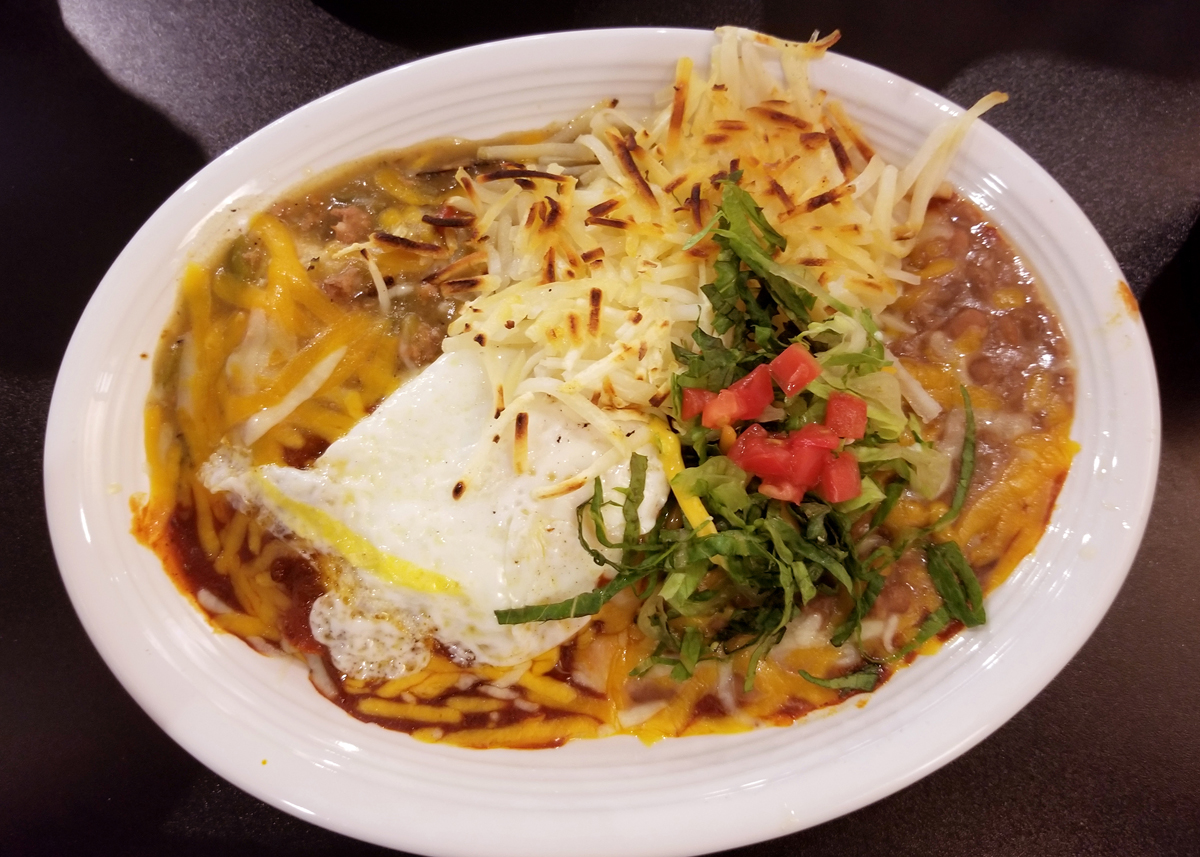
After Galisteo Basin Preserve we packed up, said our goodbyes and headed north, for home. We spent that night camped at 9000 feet in an aspen grove overlooking the Cuba Valley. In the morning, we continued north to Farmington where we stopped for a late, last hurrah New Mexico breakfast of adovada enchiladas and eggs – Christmas-style. When in New Mexico, always order, “Christmas-style,” so you get both red and green chile.
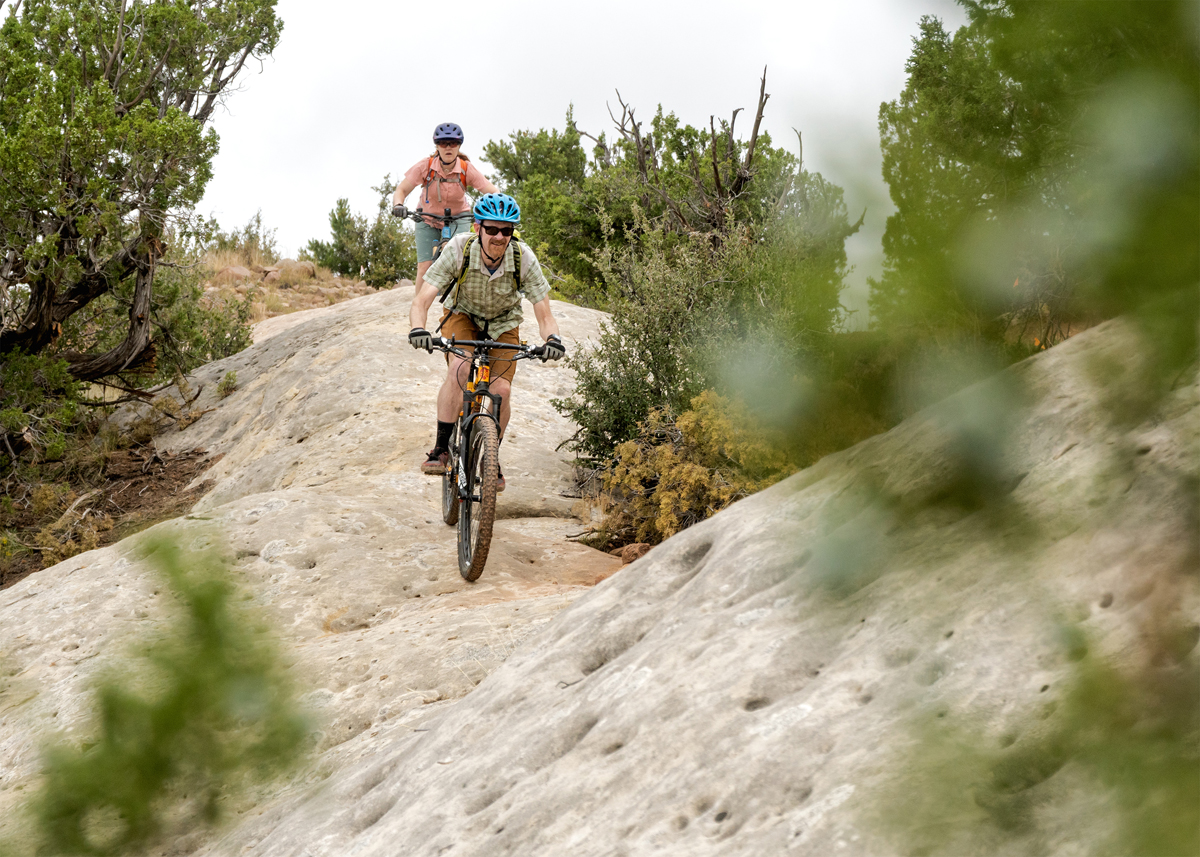
After our final plate of New Mexico chile, we headed back up through Colorado into Utah, where we spent the night camped outside of Moab. Moab was an easy drive from Farmington and left time for one more ride the next day, before we finally headed home. Since we didn’t actually get to do a lot of mountain biking in New Mexico, we planned to make up for it in Moab. Since Moab is nuts in September, we kept it simple, stayed away from the popular trails and did a comfortably-paced lower Navajo Rocks loop. It was a perfect way to wrap up our trip – mellow, scenic and fun.
As I was writing this story, I found out the Santa Fe Mountain Fest will not be held in 2020. We thought it was great but they had issues with sponsors, conflicts with other events, marketing issues, and bad weather so it wasn’t as successful as they’d expected. Hopefully this will just be a brief hiatus while they get things sorted out. Regardless, the festival was a perfect excuse for us to travel to Santa Fe, pedal some new trails and explore parts of the Southwest we haven’t seen before. Even if the festival doesn’t continue, the mountain biking, landscape, food and culture of New Mexico will all still be there. We barely skimmed the surface of New Mexico’s mountain biking options. So, I guess we’re just gonna to have to make another trip. Maybe you can join us.
If the Santa Fe Mountain Fest returns, find out more at velonewmexico.org/sfmf/


